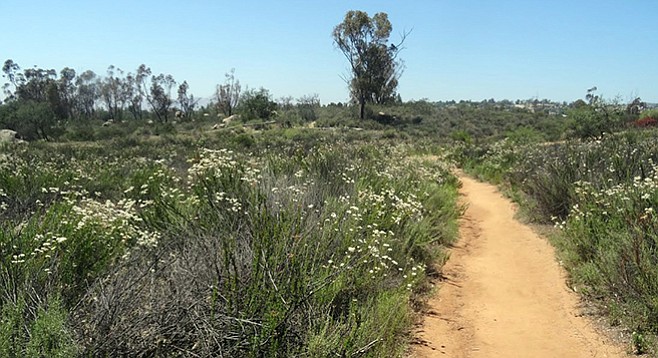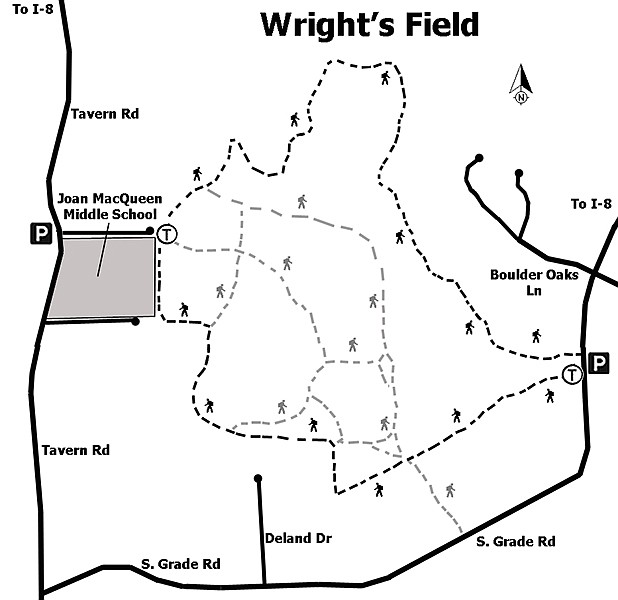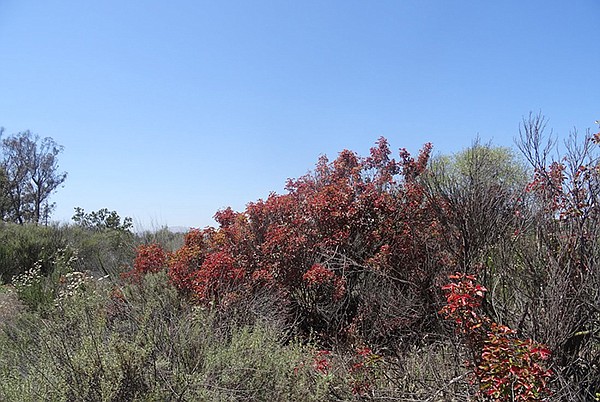 Facebook
Facebook
 X
X
 Instagram
Instagram
 TikTok
TikTok
 Youtube
Youtube

The trails along the Wright’s Field Preserve are the perfect spot to walk the family dog, go jogging, or just take a stroll on a Sunday afternoon. Historically, this area was critical to the early rancheros whose cattle could not survive on the native chaparral. Today, the “Mesa del Arroz” or “Grassy Mesa” as it was once called, is one of the best examples of native California grassland habitat in the state.
Wright’s Field is a fabulous natural beauty for anyone living near it; however, it is an especially wonderful gem as a living classroom for the students at Joan MacQueen Middle School, which shares a border with the preserve. Trips to the preserve are common by teachers and students for habitat study and inspiration. The largest distinct habitat in the 230-acre preserve is grassland made up of a mixture of native bunchgrass and non-natives such as wild oats and filaree.

From the trailhead near Joan Macqueen Middle School, visitors are greeted with a variety of path choices that will lead them through several distinct native California habitats including grasslands, oak woodlands, sage scrub, and vernal pools. The longest trail follows the field’s perimeter and is just shy of three miles. Shorter trails crisscross the field in all directions; however, visitors will need to be watchful for poison oak, which can be found throughout the preserve. Western poison oak (Toxicodendron diversilobum) is deciduous, losing its leaves in autumn then appearing as a leafless twig throughout the winter. Heading northeast from the trailhead, visitors can take the Engelmann loop, which will allow them to see the trail’s namesake, the Engelmann oak (Quercus engelmannii), up close. Also known as the Pasadena oak, these gorgeous trees have blue-green leaves and are drought deciduous. Once abundant throughout Southern California, the Engelmann oak has been on the decline since the early 1900s due to urbanization and farming. At the top of the mesa, the Engelmann forms an oak woodland in a small grove surrounded by granitic boulders.
Covering the granitic boulders all along the mesa is a colorful varnish of reds, greens, and blues. This alien-looking growth is called lichen. It is a symbiotic life form made up of algae and fungus and is a natural litmus test for good air quality.

Due to the years of grazing and modernization, a less clearly defined habitat is the sections of sage scrub. The plant species commonly found within these patches include California sagebrush, buckwheat, white sage, coyote bush, deer weed, and a variety of wildflowers. A little further north of the mesa, visitors will discover an arroyo fed by seasonal rain. The dry streambed is lined by oak, pine, laurel sumac, and toyon. However, the true gems relying on the seasonal rain, and hidden among the grasses, are the vernal pools. These ephemeral low spots fill quickly when the rain returns and can persist for weeks after it stops. The pools, formed due to the underlying hard bedrock and thick layers of clay, provide a unique habitat for a host of species only found in Southern California — creatures like fairy shrimp and the spadefoot toad.
The best time to view the pools is in spring, especially in years with heavy rain, but any time is a good time to visit the preserve as there will always be something amazing to experience.

Distance from downtown San Diego: Approximately 30 miles. Allow 45 minutes driving time (Alpine). From I-8 east, exit south onto Tavern Road. Continue south along Tavern Road until you reach the Joan MacQueen Middle School. The trailhead is just north of the middle school at the end of an unnamed private drive. Parking near the school is limited and not allowed along the private drive. Another parking option is to continue past the school until S Grade Road, turn east for 1.23 miles, and park along the street. Wright’s Field is to the west across the street. Do not pass Calle de Compadres.
Hiking length: 3-mile loop along the outer perimeter.
Difficulty: Easy, elevation gain/loss 100 feet. Dogs are allowed on leashes. Trail riding on horseback and mountain bikes is also allowed, but no off-trail excursions are permitted. No facilities.


The trails along the Wright’s Field Preserve are the perfect spot to walk the family dog, go jogging, or just take a stroll on a Sunday afternoon. Historically, this area was critical to the early rancheros whose cattle could not survive on the native chaparral. Today, the “Mesa del Arroz” or “Grassy Mesa” as it was once called, is one of the best examples of native California grassland habitat in the state.
Wright’s Field is a fabulous natural beauty for anyone living near it; however, it is an especially wonderful gem as a living classroom for the students at Joan MacQueen Middle School, which shares a border with the preserve. Trips to the preserve are common by teachers and students for habitat study and inspiration. The largest distinct habitat in the 230-acre preserve is grassland made up of a mixture of native bunchgrass and non-natives such as wild oats and filaree.

From the trailhead near Joan Macqueen Middle School, visitors are greeted with a variety of path choices that will lead them through several distinct native California habitats including grasslands, oak woodlands, sage scrub, and vernal pools. The longest trail follows the field’s perimeter and is just shy of three miles. Shorter trails crisscross the field in all directions; however, visitors will need to be watchful for poison oak, which can be found throughout the preserve. Western poison oak (Toxicodendron diversilobum) is deciduous, losing its leaves in autumn then appearing as a leafless twig throughout the winter. Heading northeast from the trailhead, visitors can take the Engelmann loop, which will allow them to see the trail’s namesake, the Engelmann oak (Quercus engelmannii), up close. Also known as the Pasadena oak, these gorgeous trees have blue-green leaves and are drought deciduous. Once abundant throughout Southern California, the Engelmann oak has been on the decline since the early 1900s due to urbanization and farming. At the top of the mesa, the Engelmann forms an oak woodland in a small grove surrounded by granitic boulders.
Covering the granitic boulders all along the mesa is a colorful varnish of reds, greens, and blues. This alien-looking growth is called lichen. It is a symbiotic life form made up of algae and fungus and is a natural litmus test for good air quality.

Due to the years of grazing and modernization, a less clearly defined habitat is the sections of sage scrub. The plant species commonly found within these patches include California sagebrush, buckwheat, white sage, coyote bush, deer weed, and a variety of wildflowers. A little further north of the mesa, visitors will discover an arroyo fed by seasonal rain. The dry streambed is lined by oak, pine, laurel sumac, and toyon. However, the true gems relying on the seasonal rain, and hidden among the grasses, are the vernal pools. These ephemeral low spots fill quickly when the rain returns and can persist for weeks after it stops. The pools, formed due to the underlying hard bedrock and thick layers of clay, provide a unique habitat for a host of species only found in Southern California — creatures like fairy shrimp and the spadefoot toad.
The best time to view the pools is in spring, especially in years with heavy rain, but any time is a good time to visit the preserve as there will always be something amazing to experience.

Distance from downtown San Diego: Approximately 30 miles. Allow 45 minutes driving time (Alpine). From I-8 east, exit south onto Tavern Road. Continue south along Tavern Road until you reach the Joan MacQueen Middle School. The trailhead is just north of the middle school at the end of an unnamed private drive. Parking near the school is limited and not allowed along the private drive. Another parking option is to continue past the school until S Grade Road, turn east for 1.23 miles, and park along the street. Wright’s Field is to the west across the street. Do not pass Calle de Compadres.
Hiking length: 3-mile loop along the outer perimeter.
Difficulty: Easy, elevation gain/loss 100 feet. Dogs are allowed on leashes. Trail riding on horseback and mountain bikes is also allowed, but no off-trail excursions are permitted. No facilities.
Comments